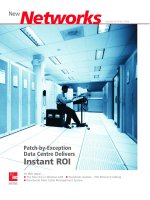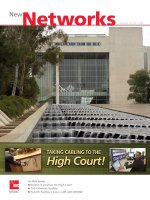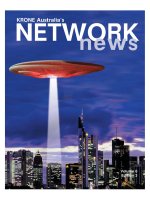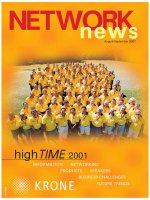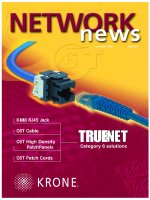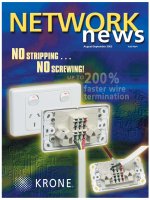Tài liệu ADC KRONE Network News - Vol.11 No.3 - 2004 ppt
Bạn đang xem bản rút gọn của tài liệu. Xem và tải ngay bản đầy đủ của tài liệu tại đây (1021.53 KB, 16 trang )
PLUS . . .
NEED FOR SPEED
— THE GRID APPLICATION FOR 10 GIGABIT
10 GIGABIT COPPER — THE FACTS
MAKING THE IMPOSSIBLE POSSIBLE
Vol11 No3 2004
A
s the worldwide leader in
telecommunications infrastructure,
KRONE has a knack for making the
impossible, possible. At the IEEE 10
Gigabit Ethernet standard working group
meeting, this proved to be the case when
KRONE introduced the industry’s first
augmented Category 6 cable. This cable
comprised the necessary characteristics to
enable 10 Gigabit Ethernet to be
implemented over unshielded twisted
pair (UTP) to the full 100 metres required
for structured cabling systems.
I’m pleased to announce that this
astounding breakthrough, is now available as a
complete end-to-end cabling system
appropriately named KRONE CopperTen
™
,
delivering an easier to install and more cost-
effective solution than shielded and fibre optic
cabling systems, revolutionising the future of
networking forever.
KRONE CopperTen was successfully launched in
Australia at the recent CeBIT exhibition. Aimed at
providing ICT solutions for tomorrow’s business
world, CeBIT was the perfect place to showcase
KRONE’s latest innovation, generating a great
deal of interest amongst the IT community.
Inside this special edition of Network News we
provide you with a closer look at KRONE
CopperTen and what makes it so revolutionary.
On page 6, Glen Johnston’s overview on the
evolution of the 10 Gigabit copper phenomenon
dispels the myths currently surrounding this new
technology.
While on page 8, Peter Meijer takes an in-depth
look at the science behind KRONE CopperTen,
reviewing the attributes of the world’s first
10GBASE-T UTP cabling system.
KRONE understand cabling infrastructure is a
long-term investment and now CopperTen
provides customers with a truly flexible, future
proofed solution. On page 4, Rob Milne discusses
this from an IT Manager’s perspective, detailing
the applications for a 10 Gigabit Ethernet UTP
cabling system.
We expect KRONE CopperTen to find its first
applications in data centres, medical facilities,
higher education campuses and enterprises that
routinely work with large electronic files requiring
increased bandwidth.
I’m sure you’ll agree that the advantages of KRONE
CopperTen are nothing less than remarkable.
It represents the next generation in structured
cabling technology and will bring tremendous time
and cost savings, as well as increased productivity
to installers and customers alike.
Sincerely
Craig Jones
CEO
2
NETWORKnews
GOING THE DISTANCE!
Copper cable and KRONE ingenuity take 10 Gigabit Ethernet to a whole new
dimension
Customer Stories
12 Stylish HIGHBAND
®
25 Eliminates
Security Issues
14 Robust HIGHBAND 25 Powers On
In Remote Mining Network
Product Update
8 Making the Impossible Possible
Business Articles
4 The Need For Speed… The Grid
6 10 Gigabit Copper: The Facts
KRONE News
3 CopperTen
13 Club KRONE Update
16 Environmental High
Editor: Joanna Parsons
Art Direction: Nora Collins
Website: www.krone.com.au
Email:
CONTENTS
Copyright © 2001 KRONE Australia Holdings Pty. Limited
C
eBIT Australia, the major international
information and communications technology
exhibition in Australia, was recently held at
Darling Harbour from 4 to 6 May.
Considered by many as the IT industry’s “One
Stop Shop”, CeBIT provides visitors with the
opportunity to view the latest systems, services
and trends for information technology. As such,
it was the perfect platform to launch KRONE’s
latest innovation, with visitors witnessing the
Australian release of the world’s first 10 Gigabit
UTP cabling system. Our new end-to-end suite of
cable and connector products aptly titled, KRONE
CopperTen, became the subject of great interest.
With the CopperTen solution as the major focus
of our stand this year, KRONE sales executives and
product specialists were kept busy answering
inquiries from visitors keen to learn more about
this revolutionary technology.
In fact, I’m pleased to say that the 10 Gigabit
portfolio of products generated a great deal of
discussion. As a result, we are expecting to see a
large uptake of this technology in networks being
installed in the near future. We anticipate as new
technologies emerge, network users will quickly
realise the benefits provided by KRONE
CopperTen’s advanced infrastructure.
Overall it was another successful showing for
KRONE and the CeBIT organisers, with
approximately 500 exhibitors from 15 countries
and more than 25,000 visitors in attendance
during the three days. It’s pleasing to note that
this exhibition is continuing to grow from
strength to strength and is now an important part
of the KRONE calendar, providing the ideal
opportunity to showcase our latest innovations,
like CopperTen, to the marketplace.
Thank you to those of you who took the time
to visit the KRONE stand and learn more about
our new CopperTen technology. For those of you
unable to attend, we look forward to seeing you
next year.
NETWORKnews
3
COPPERTEN
™
KRONE launches world first at CeBIT.
By Trevor Kleinert, RCDD,
National Sales Manager
Premis
NET
, Manager Fibre
Optics Division,
KRONE Australia
We anticipate as new technologies
emerge, network users will quickly
realise the benefits provided by
KRONE CopperTen’s advanced
infrastructure.
Cross-section of KRONE CopperTen cable.
K
RONE’s CopperTen
™
announcement for 10 Gigabit,
cost effective, connectivity over copper is the
catalyst that will enable a whole new generation of IT
applications to transform computing and business. This
will accelerate the adoption of realtime IP based
applications to the desktop in terms of both bandwidth
and number. Applications that have emerged in the last
couple of years will become commonplace and be
entrenched as key enablers of business. Just as email
has in the past five or so years, the next five years will
see VoIP, video, security and distributed computing
applications such as SANs, server clusters and grid
computing become standard in a modern computing
environment.
Any organisation considering the cabling of new
premises or perhaps the re-cabling of an existing site,
should give serious thought to the next generation of IT
applications which will be a pre-requisite for business
over the next five years. Typically cabling plant will be in
service in a building for up to 10 years, sometimes
longer, the number and nature of IT applications this
cable will be required to support will increase and each
application employed will also go though a number of
generations. If a decision on cabling is being made
today, then only the fastest performing and highest
quality cabling and connectivity should be considered if
bottlenecks and restrictions to business processes are
not to be encountered down the track.
Post Y2K and the dotcom crash, most IT
departments are being forced to do more with less,
deploying more and sophisticated applications, but
with less resources. Budgets are tight, resources are
thin, and skilled IT resources can be scarce or
expensive. This has certainly accelerated the use of IP
based technologies as a common network
infrastructure, for all applications, based on one set of
rules, requiring less resources to manage. IT
departments invest heavily in servers and mainframes
to cater for an ever increasing number of applications,
their complexity and intensive resource requirements.
Within three to four years these servers become
obsolete or lack the necessary computing power as
application resource requirements increase
relentlessly; then another expensive server investment
cycle begins.
What organisations need is to break this cycle, they
don’t need more expensive CPU processing power, but
rather more efficient use of existing CPU processing
resource. Against this backdrop are today’s powerful
desktop PCs which only use 5 to 10 percent of their
capacity most of the time.
Organisations need a way to tie all of these idle
machines together into a pool of potential computing
resource, whilst providing secure and reliable access. If
an organisation could use all of its desktop PCs idle
CPU cycles to run memory- and processor-intensive
tasks they could get more work done faster, possibly
get to market faster, and at the same time reduce their
IT expenses.
The opportunity represented by idle computers has
been recognised for some time. In 1985, Miron Livny
showed that most workstations are often idle, and
proposed a system to harness those idle cycles for
useful work. This branch of distributed computing
which brings the power of clustered desktop
computers to compute intensive applications is known
as “grid computing”. A grid enables the massive
integration of computer systems to offer performance
unattainable by any single machine by co-ordinating
distributed computer resources (desktop PCs,
workstations, server blades and SANs) through the use
of smart systems for scheduling and management.
The integration of these systems will be so
transparent that users will no more notice they are on
a network than motorists pay attention to which
cylinder is firing at any given moment. Analagous to an
electricity grid where power grid users have and need
no knowledge as to the source and location of power
stations. To people logging onto a grid, the system will
look like just another set of programs running on their
office computers, indeed transparent within an
4
NETWORKnews
THE NEED FOR SPEED THE GRID
Applications for 10 Gigabit UTP technology.
By Rob Milne, Business
Development Manager,
KRONE Australia
The grid interconnect will be a key
driver for 10 Gigabit Ethernet
networking in the horizontal to
the desktop.
NETWORKnews
5
application. The grid may be a locally established
resource to solve business problems, a database
application perhaps, it may be made up of a number of
grids working jointly across departments, a whole
organisation or perhaps across the country or the world
connected via high speed internet links.
Once the realm of scientific, defence and research
organisations, advances in clustered computing power,
faster networks, and shared storage are placing the
benefits of grid computing within reach of even the
most cost-conscious businesses today.
But this is not some futuristic technology, financial
services firms are using grid computing today to
prepare complex models of individual currencies or
complete portfolios, and get the results quickly enough
to trade based on the model’s predictions. Grid
computing is an ideal technology suited to startups
who require massive computing power for low cost.
Grid computing was a good choice for start-up
Butterfly.net, developers of a framework for multiplayer
online games. Butterfly.net’s CEO David Levine is bullish
on the technology. “In five years, I can’t imagine a
company not using a grid,” he says.
Mainstream hardware and software vendors are now
shipping products to both enable and take advantage
of grid computing technologies. Apple’s Xgrid, Oracle’s
Database 10
g
, Sun’s N1 Grid Engine technology and
IBM’s zSeries hardware and grid software
tools to name a few.
Grid computing is emerging as a viable
technology that businesses can use now
to extract productivity out of IT resources.
According to independent market analyst
IDC, grid computing in the manufacturing
sector is projected to be a $2.6 billion
market opportunity by 2006. IDC projects
the total grid opportunity at more than
$13 billion by 2007, a compound annual
growth rate of 83 percent. Technology
Review magazine named grid computing
as one of the ten technologies that will
change the world.
Reliability and performance are critical
to a grid environment, if the grid doesn’t
perform, then the business case for it
certainly diminishes. In a traditional server the “bus” is
the interconnect between the CPU, memory, storage
and I/O resources. This spans distances of millimetres or
centimetres on the server’s main circuit boards. This is a
very reliable, low latency interconnect moving vast
amounts of data between the servers core components
in fractions of a second. In a local grid or distributed
computing environment, where a virtual server is
created out of tens, hundreds or thousands of
interconnected PCs, SANs and other compute
resources, the horizontal interconnect, the passive
structured cabling and active network components;
becomes the new server bus. Latency, bandwidth and
reliability become absolutely critical in this new
network environment. The grid interconnect will be a
key driver for 10 Gigabit Ethernet networking in the
horizontal to the desktop.
Grid computing will possibly be the killer application
for 10 Gigabit networking in the horizontal
interconnect and KRONE’s CopperTen solution will be a
catalyst to make it mainstream.
Grid computing is an ideal
technology suited to startups who
require massive computing power
for low cost.
Grid computing eliminates server redundancy.
I
f we look back over history, there is an observable
cycle out of which has grown the dominance of
Ethernet - and which causes the ever-present desire of
network managers to ‘future proof’.
Moore’s law states that computing power doubles
every 18 months. It does not apply directly to active
equipment and cabling, but it is a significant driver.
Active equipment roughly follows a four-year lifecycle.
Now here lies the difficulty for network managers.
Computers are being changed out every two to four
years; actives every four years - yet the cabling
infrastructure is expected to last 10, 15 perhaps even
20 years.
So it’s quite evident that structured cabling capability
has to lead active equipment deployment. In practice
by between four and six years.
ALIEN FORCES
There are two technical problems to be overcome in the
move from Gigabit to 10 Gigabit/s. One is the much
greater insertion loss of twisted pair at 625MHz. The
other is Alien Crosstalk - signals induced from adjacent
cables that cannot readily be cancelled electronically.
Developing a cost-effective, practical 10 Gigabit/s
system relies heavily on the passive cabling to
counteract these two problems.
So difficult, in fact, is this task that until November
2003 most people in the cabling industry believed that
an unshielded (UTP) approach was not possible and
that shielded cabling was the only solution. Indeed,
several were proposing to exclude even the possibility
of an unshielded (UTP) cabling solution from the up-
coming 10 Gigabit/s Ethernet standard.
It was only at the eleventh hour, after some of the
fastest and most innovative development ever in the
structured cabling sector, KRONE’s laboratories
produced a real proof-of-concept copper cable. After
careful measurement and external validation by one of
the active electronics manufacturers - KRONE were able
to demonstrate to the IEEE study group that 10
Gigabit/s over 100 metres of UTP was indeed a practical
proposition.
SHIELDED OR UNSHIELDED
From the late 80s - perhaps earlier - there has been
disagreement in the industry and around the world as
to whether shielded or unshielded cabling solutions are
the best, with many companies backing one horse or
the other - and then trying to convince the market that
theirs’ is the only way.
KRONE, on the other hand, as a major global player,
has always recognised that both are used in different
situations and that whilst STP/FTP might be the solution
of choice in some markets, UTP will be preferred in the
majority of the markets.
Whilst custom and practice in Germany and central
European countries is to use shielded solutions, most of
the world is UTP-centric. In fact, in 80 percent of the
world, the skillbase of network designers and installers
is in unshielded twisted pair technology and systems.
This is why KRONE worked against almost impossible
odds to prove to the industry that a UTP
implementation of 10 Gigabit/s was possible.
Otherwise, over the coming years, the industry would
have found a situation where every installer would have
had to be re-trained and up-skilled to be able to
undertake the more complex, and far less forgiving task
of installing shielded systems. This in turn would have
6
NETWORKnews
10 GIGABIT/S COPPER: THE FACTS
Dispelling the myths surrounding the new 10 Gigabit UTP phenomenon.
By Glen Johnston,
Manager Marketing and
Product Development,
KRONE Australia
Generally the structured cabling solution is needed
four to six years before the relevant Ethernet
ports are installed in bulk.
added three extra cost elements into the 10 Gigabit/s
solution - the higher cost of screened cables, the higher
labour costs of slower installation and the on-cost of
installer re-training.
But let’s be clear. KRONE is not saying that UTP is the
only solution. We always develop shielded solutions so
that KRONE users worldwide have choice.
PROPHETS OF DOOM
Already there are prophets of doom claiming that
KRONE is being premature, signalling the launch
of a 10 Gigabit copper cable before there is even
a draft standard.
Let’s take a reality check from history.
In the late 80s IBM Type 1 shielded cable and
10BASE-2 and 10BASE-5 co-ax users migrated in their
droves to UTP. In fact, some 30 percent of the market
had chosen to install UTP before there was a UTP
standard.
A little later - even though a standard (10BASE-T4)
existed to carry 100 Mbit/s Ethernet over Category 3 -
users saw that there was a new emerging technology
now called “old Category 5”. Despite the fact that the
cable was 30 to 40 percent more expensive, large
numbers of users chose to install it because they
recognised that Category 3 would go no further.
Did the market wait for a ratified international
Category 5 standard? Of course not. By 1999, 40
percent of the market was buying the new “pre-
standard” Category 5 cables (Category 5e in North
America) and 20 percent of switch ports were
Gigabit.
The cycle continues with Category 6 - which the
world has been installing for the last four or five years.
Yet there was no ratified standard until 2002.
CAN’T WAIT. WON’T WAIT
Network managers now know that 10 Gigabit/s
Ethernet is happening. They can expect to see cabling
systems this year that will support a 10 Gigabit/s 100
metre copper channel. And in 2005 it is already
estimated that 7 percent of switch ports will ship as 10
Gigabit/s Ethernet. By 2007 we can expect to see a
large proportion of cabling installs being copper and 20
percent of switched ports being 10 Gigabit/s.
If they don’t need to deploy a new network or
extend their existing one, there’s a lot to be said for
waiting. But in reality few network managers have
static networks.
EARLY ADOPTER RISK
As ever, being an early adopter is not without risk. For
example, a number of other cable and connector
manufacturers have been promoting “Category 6e”
products that have focused on improving the internal
electrical performance of cables and connectors. As it
turns out, these “improvements” have proved to be
exactly the opposite when it comes to alien crosstalk -
the killer factor for 10 Gigabit/s. Instead, “augmented
Category 6” - on which the KRONE copper solution is
based - is the current clear favourite.
THE BOTTOM LINE
10 Gigabit/s Ethernet over twisted pair copper is certain
to become a standard. A structured cabling solution is
needed. Generally the structured cabling solution is
needed four to six years before the relevant Ethernet
ports are installed in bulk.
Network managers need workable solutions as early
as possible. Many cannot afford to wait for ratified
standards. KRONE’s copper solution will offer users the
latest technology based on the latest information. It
outperforms the requirements of all the Ethernet
solutions currently being studied.
There is always a risk in deploying a pre-standard
solution.
Often there is a bigger risk in not trying to future-
proof a network installation.
Ultimately KRONE believes that customers should be
offered choices and the best possible information to
help them make an educated decision based on their
individual circumstances and aspirations.
F
or years, copper UTP solutions have been the
preferred medium over which most Local Area
Networks communicate. And in this same period, a
debate has raged as to when fibre would displace
copper as the preferred infrastructure. Several years
ago Gigabit Ethernet seemed like a pipe dream, yet
today Gigabit switch port sales have overtaken
10/100BaseT of old.
Fibre, has for years, led the Ethernet industry forward
in port speed progression. So if fibre is one step ahead,
doesn’t it replace copper? The answer is quite simple.
To convert electrons to photons and then back to
electrons adds cost (from an active hardware
perspective). This makes the cost of fibre optic active
hardware as much as six times more expensive per port
today than the equivalent speed copper UTP solution
on Gigabit Ethernet switch ports.
With Ethernet now the winner of the horizontal
desktop LAN protocol war, a pattern has arisen with
regards to transportation speeds. Migration from
10BaseT to 100BaseT and now Gigabit Ethernet
(1000BaseT), the transportation speed has always
progressed tenfold. Where we are today, with regards
to protocol advancement, is no different.
Ten Gigabit Ethernet is alive and breathing today in
the form of fibre optics. The year 2003, particularly the
last quarter, was pivotal in the old question of “when
will copper reach its limit”? By the title of this paper
you might surmise, once again, someone has figured
out a way to produce a copper networking solution to
support 10 Gigabit.
The cabling industry and TIA/EIA don’t drive the
electrical parameters needed to run transmission
protocols. It is the IEEE who develops proposed
protocols, understands what is needed from an
electrical standpoint and then gives the cabling
standards bodies responsibility of developing
measurable parameters for cable (with the possible
exception of Category 6 – See “The Future of UTP” for
a better understanding). This was no exception for 10
Gigabit Ethernet. An IEEE 802.3 study group was
formed to discuss how best to approach running 10
Gigabit transmission over a copper infrastructure. This
group is composed of representatives from several
different aspects of the networking community, such as
chip manufacturers, hardware manufacturers and
cabling/connectivity manufacturers.
The 10GBaseT working group discussions include
which protocol encoding will be used, how it relates to
the needed bandwidth from the cabling infrastructure
(what the frequency range is) and what measurement
of Shannon’s Capacity is needed to support them.
A definition of Shannon’s law is given below. The value
for the capacity is measured in bits per second.
To achieve 10Gbps of transmission, a Shannon’s
capacity of >18Gbps is required from the cabling
solution. The additional capacity over the desired data
rate is due to the amount of bandwidth used within the
active hardware noise parameters i.e. Jitter,
Quantisation, etc.
SHANNON’S LAW (CAPACITY)
It is one thing to understand how this law works, but
another to meet the much needed channel capacities
required to run protocols. That being said, the
following is the basic formula for understanding how
efficiently a cable can transmit data at different rates.
Concerning a communications channel: the formula
that relates bandwidth in Hertz, to information
carrying capacity in bits per second. Formally:
Q = B log2 (1 + S)
Where Q is the information carrying capacity (ICC), B
is the bandwidth and S is the signal-to-noise ratio.
This expression shows that the ICC is proportional to
the bandwidth, but is not identical to it.
The frequencies needed to support the different
proposed encoding schemes (to achieve a full 10
Gigabits) were now extending out as far as 625MHz. It
quickly became evident that the signal to noise ratio
within a cabling solution could be predicted, and
therefore, cancelled out within the active electronics. But
a random noise source, Alien Crosstalk, also now existed
from outside the cable. This noise source would need to
be measured and reduced to achieve the Shannon’s
Capacity requirements of the cabling solution.
8
NETWORKnews
KRONE’s CopperTen
™
Cabling Solution.
MAKING THE IMPOSSIBLE POSSIBLE
by Peter Meijer, JP BE
MSc, RCDD,
Technical Training
Manager and Industry
Liaison,
KRONE Australia
You may be aware of how the industry currently
prevents the effects of crosstalk within cables. The pairs
within a single cable are twisted at different rates (as
the different colours in the cable would indicate). These
different rates are used in an effort to minimise the
crosstalk between pairs along parallel runs. While this
works well within the cable, it doesn’t do much for
cable-to-cable crosstalk (Alien Crosstalk).
Alien Crosstalk is quite simply the amount of noise
measured on a pair within a cable induced from the
pairs in an adjacent cable. This is not only a concern
for different twist lay pairs between cables, but
more so between same twist lay pairs between
adjacent cables.
Initial testing on existing Category 6 UTP cable
designs quickly showed that the rationale behind
reducing the impact of crosstalk between pairs, within
a cable, could not support Alien Crosstalk
requirements. Twist lay variation and controlled
distances between the pairs have been standard design
practice for achieving Category 6 compliance. While
the distance between pairs can be controlled within a
cable jacket, it could not be controlled between same
lay length pairs on adjacent cables.
Testing to Shannon’s Capacity on existing Category
6 UTP solutions only yielded results in the 5Gbps
range. The results achieved previously did not provide
the needed additional throughput to allow for active
electronic anomalies. This was a far cry from the
desired 18Gbps. Therefore posing the question: Is
there a UTP solution capable of achieving the needed
Alien Crosstalk requirements or would fibre finally
rule the day? The August 2003 meeting of the
10GBASE-T working group would yield three main
proposals as a result.
1. Lower the data rates to 2.5Gbps for Category 6
UTP. This would be the first time fibre would not
be matched in speed and that a tenfold increase
in speed would not be achieved.
2. Reduce the length of the supported channel
to 55m from the industry standard 100m for
Category 6 UTP. This would greatly impact the
flexibility of the cabling plant, considering most
NETWORKnews
9
Figure 1. Example of a centre cable being impacted by
the adjacent 6 cables in the bundle.
Figure 3. The star filler used within several Category 6
cable designs increases and controls the distance
between pairs.
Figure 2. Example of how cables with same twist lays
impact one another.
Figure 4. While the distance between pairs within the
same cable is maintained, the distance between same lay
lengths on adjacent cables is still compromised.
facilities are designed with the 100m distance
incorporated into the floor plans.
3. Use shielded solutions and abandon UTP as a
transport medium for 10 Gigabit. This would
mean returning to ScTP/FTP type solutions,
requiring additional labour, product cost and
grounding, as well as space.
Category 5e would also be dropped as a proposed
transport medium entirely. The active hardware and
chip manufacturers would now be faced with a lesser
solution than the already available fibre optic solution.
And, questions would now be raised concerning the
value of producing such active hardware to support
transmission rates that only increased by 2.5 times, or
if distance limitations of 55m were really worthwhile?
Would the additional cost of installing a shielded
solution outweigh the benefits in cost for the active
components?
The next meeting of the working group would be
pivotal in addressing the above questions. UTP could
very well have reached its limit.
KRONE’S INNOVATION: COPPERTEN™
A momentous challenge was now presented. How
could a UTP cable achieve the desired Shannon’s
Capacity of >18Gbps and maintain the 100m distances
to which the industry has become accustomed while
remaining within normal size constraints?
In response to the challenge, KRONE’s research and
development team quickly went to work. Working
within a very short developmental timeframe several
innovative ideas were presented, tested and then put
into production. As a world first, the KRONE R&D team
presented a solution to the 10 Gigabit, 100m UTP
problem.
ADDRESSING PAIR SEPARATION
With standard Category 6 cable construction the pair
separation within the cable is counter productive for
pair separation between cables. The often-used star
filler pushed the pairs within the cable as close to the
jacket as possible leaving same pair combinations
between cables susceptible to high levels of Alien
Crosstalk. With KRONE’s new design of CopperTen
™
cable, the pairs are now kept apart by creating a
higher degree of separation through a unique oblique
star filler design. Crowned high points are designed
into the elliptical filler to push the cables away from
one another within the bundle in a spiral helix. This is
very similar to a rotating cam lobe.
Due to the oblique shape of the star, the pairs remain
close to the centre, while remaining off-centre as the
cable spirals along its length, creating a random
oscillating separation effect. The bundled cables now
have sufficient separation between same lay length
(same colour) pairs to prevent Alien Crosstalk from
limiting cable performance.
10
NETWORKnews
Oblique, elliptical,
offset filler, which
rotates along its
length to create an
air gap between
the cables within a
bundle.
This separation can be better understood through
the actual cross-section below.
KRONE’s unique design keeps cable pairs of the
same twist rate within different cables at a greater
distance from one another than in the past. Similar to
KRONE’s patented AirES® technology cable design, air
is used between these pairs.
This effect is even more dramatic when viewed from
the side of a cable bundle. The peaks of the oblique,
elliptical filler (red arrows) are used as the contact
points along the length of the run (see picture next
page). These provide the greatest distance between the
actual pairs by vaulting the sides of the ellipse (yellow
arrows) where the pairs are housed.
The reduction of Alien Crosstalk is now greatly
improved over the standard design Category 6 cables
we use today. The following chart compares
measurements made on standard Category 6 cable and
the new CopperTen™ cable. The improvements are
approximately 20dB better on CopperTen than the
standard Category 6. To put this in perspective: for
every 3dB of extra noise there’s a doubling effect
resulting in KRONE CopperTen cable being more than
six times less noisy than standard Category 6 cable.
For the purpose of comparison, the Category 7 limit
line was used to show the dramatic improvement in
reducing Alien Crosstalk.
With KRONE’s CopperTen cabling system the
industry has now taken that next leap. Copper UTP has
been given another lease on life to support the next
future proofing step in a 10 Gigabit transport protocol.
The cost of active hardware will remain in check and be
cost effective for future advancements in data transfer
rate speeds.
NETWORKnews
11
T
he Department of Natural Resources, Mines
and Energy (NRM&E) is responsible for
ensuring the sustainable management and use of
Queensland’s land, water, vegetation, mineral and
petroleum resources.
With over 80 offices and service centres
throughout Queensland, the Department collects
and stores information about the state’s natural
resources. Combined with data about natural
resource management and development from
other organisations, this information is used in
making decisions about the sustainable
management of Queensland’s natural wealth.
To do this, they work with the community to
develop and implement plans, policies and
evaluation systems. The Department’s role
includes administrative functions (eg. land titling,
valuations), regulatory functions (eg. issuing of
permits and licences), science and research,
assessment and monitoring of natural systems
and risk monitoring.
In June 2003, as part of a departmental
initiative, NRM&E’s Townsville office were looking
to improve on the performance of their existing
network and at the same time upgrade their
system to accommodate any future requirements.
At the time, the Department’s current system
contained a mix of products from various
suppliers and had not only been outgrown by
their existing needs, but had also become an
unruly tangle to try and maintain.
Chris Bedson, NRM&E’s IT Manager,
commented, “With its hard-wiring of the cabling,
the KRONE product solution offered the neat,
workable racks we needed, providing more
control and minimising users swapping patch
leads in and out.”
In addition, the Department also wanted to be
able to update their existing system for VoIP
capabilities, allowing for the jumpering of phone
points when staff moved workstations.
To meet these requirements NRM&E chose a
KRONE HIGHBAND 25 Category 6 solution.
Once decided upon, NRM&E’s Project Services
division issued a request for tender to secure a
KRONE endorsed installer to complete the
installation of the selected HIGHBAND 25 system
to certification standards, enabling the full 20-
year warranty.
Mr Bedson said, “Choosing a certified installer
was important for the Department as the
warranty, whilst not the decisive factor, certainly
helped in influencing the decision we made.”
As a result of the tender process, experienced
installer Multicom was selected to carry out the
project. Based in North Queensland, Multicom
specialises in the supply and installation of voice
and data cabling. Multicom had previously
completed work for NRM&E and were regarded
highly by the Department’s IT staff.
The installation commenced in September 2003
under the guidance of a detailed project plan
divided into individual stages. Level 2 of the
Townsville building was completed first to ensure
all network operations were still up and running
whilst the new system was being installed.
The total installation included 600 outlets,
approximately 30,000 metres of Category 6 UTP
cable and 15 300 pair HIGHBAND 25 kits.
The project ran smoothly and was completed to
schedule in April 2004. The Department were
particularly impressed by the on-site supervision
of the contracted installers by KRONE, ensuring all
work was being completed satisfactory and in
accordance with the certification requirements.
The newly installed KRONE cabling system is
now successfully providing increased performance
to the Department’s network of computers,
printers and telephones within the Townsville
office.
To date NRM&E have been extremely happy
with the KRONE product’s performance. Mr
12
NETWORKnews
STYLISH HIGHBAND
®
25 ELIMINATES S
KRONE’s HIGHBAND 25 solution provides the ultimate IT resource
management for Queensland’s Department of Natural Resources, Mines
and Energy.
“With its hard-wiring of the cabling, the KRONE
product solution offered the neat, workable racks we
needed, providing more control and minimising users
swapping patch leads in and out.”
By Mike Hubbard, North
Qld Sales Executive,
KRONE Australia
CLUB KRONE
UPDATE
D
uring a recent visit to Canberra,
I had the opportunity to present
several Club KRONE Awards to
members that had achieved Top 10
status in 2003.
This also gave me the opportunity
to visit a number of customers that I
have been dealing with over the years
both on the Helpdesk and as the
Manager of Club KRONE.
I was pleased to see that upon
arrival in a number of company
receptions that previous Club KRONE
Awards were proudly on display.
Congratulations to the following
members for achieving Top 10 Awards in 2003:
- DESA Australia (Qld) Pty Ltd
- Diverse Data Communications
- Newscom
- DESA Australia (Vic) Pty Ltd
- Expert Data Cabling Pty Ltd
- Data & Voice Pty Ltd Communication Services
- Allied Technologies Group (ACT) Pty Limited
- Office Project Services
- Tri State Electrical & Communications Pty Ltd
- Allied Technologies Group (Qld) Pty Limited
NEW LOOK CLUB KRONE WEB PAGE
Y
ou asked for it and here it is! Members are no longer
required to enter their membership number and password
to access the majority of invaluable information on the Club
KRONE website.
You can now directly access the following areas:
-Tech Tips
-News and Events
-Product Focus
-Standards and Regulations
-KRONE Contacts
-Plus much more!
Access to the points/redemption area of the website will still
require your Club KRONE membership number and password
however, I am confident you will find this improved website
beneficial and I would be pleased to receive any feedback you
may have.
Bedson, said, “The appearance of the new HIGHBAND 25
system is a great improvement, it looks good and certainly
gets rid of the cabling birds nest we previously had.”
After such a favourable implementation, it is now
envisaged that the KRONE structured cabling system will
become the departmental standard for NRM&E and will
eventually be installed in other offices as new fit-outs are
completed.
NETWORKnews
13
SECURITY ISSUES
“The appearance
of the new
HIGHBAND 25
system is a great
improvement, it
looks good and
certainly gets rid
of the cabling
birds nest we
previously had.”
By Mark Meyer,
Club KRONE Manager,
KRONE Australia
BEFORE
AFTER
B
HP Billiton Mitsubishi Alliance (BMA) is
Australia’s largest coking coal producer and a
leader in the international coal industry,
accounting for more than 28 percent of the
world’s seaborne trade in metallurgical coal.
BMA’s mines supply quality coal for both domestic
and international customers. The mines have a
capacity to produce over 50 million tonnes of coal
annually, comprising high quality coking coals, weak
coking coals, PCI coals and thermal coals, which are
sold to over 70 customers in 24 countries.
BMA is distinguished by the quality of its assets,
its commitment to sustainable development and
support for the communities in which it operates.
In July 2003, BMA set out on a massive
operation to upgrade the network infrastructure
of approximately sixteen sites throughout Central
Queensland. No easy task when you take into
consideration the remote locations of the BMA
coal sites and the actual distances between them.
BMA’s mines are located in the Bowen Basin,
which covers an area of 75,000km² of Permian
Age marine and freshwater sediments. The basin
is roughly triangular in shape, extending around
550km from its northern peak at Collinsville,
southwards to its base at Theodore, where it is
approximately 250km wide.
Previously, BMA had been using a combination
of Category 3 and Category 5 solutions at their
various mine sites. As a result, they were looking
to upgrade their existing systems to provide
increased performance and communications
capabilities for these remote locations.
BMA insisted on a solution that could provide
them with a secure system and KRONE’s unique
HIGHBAND 25 patching system proved to be the
most suitable. Mr David Mumford, Manager IT,
BMA said, “We were particularly impressed by the
HIGHBAND 25’s neat and manageable patching
environment that also maintains the integrity and
security of the network, eliminating any non-IT
staff from completing simple adds, moves and
changes without the IT Department’s approval”.
With the exception of the Crinum operation,
BMA’s mines are open cut, using dragline and
truck/shovel fleets for overburden removal. Coal
seams are mined by front-end loader and
hydraulic excavators, and coal is transported to
mine preparation plants by large capacity haul
trucks. This environment is extremely volatile and
it was imperative that the new cabling system
chosen be a robust architecture, able to withstand
heat and dust.
Due to the size and extent of the project, BMA
made a decision to choose two individual KRONE
endorsed installers to complete the installations,
each chosen to focus on two separate aspects.
Hoban Smith Industries were contracted to install
the horizontal copper and selected fibre cabling
to all sites and buildings, as well as being
14
NETWORKnews
ROBUST HIGHBAND
®
25 POWERS ON IN
BMA Coal depends on KRONE HIGHBAND 25 durability for vital
communications in remote Central Queensland mining network.
“We were particularly impressed by the
HIGHBAND 25’s neat and manageable patching
environment that also maintained the integrity
and security of the network ”
By Scott Whiston,
Qld Sales Executive,
KRONE Australia
IN REMOTE MINING NETWORK
responsible for ongoing maintenance, extensions
and upgrades. While, DESA Australia Pty Ltd,
were employed to install the HIGHBAND 25
frames, active racks, and computer room
infrastructure for data and power.
As an experienced installer, DESA were able to
provide BMA with a professional multi-trade
cabling service. Hoban Smith Industries were
selected on the basis of their reputation for
quality and proven track record of installing the
KRONE product solution chosen.
With a broad range of expertise between the two
chosen installers, BMA were able to call upon them to
provide preliminary recommendations on the KRONE
product solution during the initial auditing stage.
As a large scale operation, BMA’s IT
Department prepared an in-depth project plan for
the installation, ensuring all BMA cabling
specifications and BMA HSEC and standard
operating procedures would be met.
The installation of the KRONE HIGHBAND 25
solution is now well under way at BMA mine sites
in Moranbah, Goonyella Riverside, Peak Downs,
Saraji, Dysart, Norwich Park, Gregory, Crinum,
Blackwater, Emerald, Hay Point and Mackay as
well as their Brisbane Head Office. Once
complete, the entire installation will encompass
some 4000 to 5000 outlets in approximately
seventy BMA locations and buildings. Working in
conjunction with other project teams DESA
commented that it became imperative each site
shutdown be completed to deadline. Often
working against the clock to convert over to the
new computer room infrastructure and KRONE
HIGHBAND 25 distribution system.
The vast area the project encompasses, the
remoteness of the sites and the volatility of the
environment have presented installers Hoban
Smith Industries with many challenges whilst
installing the KRONE Category 6 integrated
infrastructure. A strong commitment to BMA’s
safety protocols and procedures as well as the
ever evolving industry requirements and
standards, meant Hoban Smith Industries had to
work side-by-side with BMA personnel to install
the product in these challenging locations,
requiring particular attention to installation
variables such as mechanical protection,
segregation, heat and dust. Some locations also
required the integration of the KRONE product
with VoIP and radio networks for delivery of data
and voice to extremely remote buildings.
The proprietors of Hoban Smith Industries,
Travis Hoban and Jason Smith, both endorse the
KRONE product as resilient and reliable with a
proven track record. Mr Smith commented,
“HIGHBAND 25 has proven to be a flexible, easily
expandable, high-density solution that suits
BMA’s requirements very well”.
The newly installed systems will be responsible
for providing mining staff, administration staff
and emergency personnel with vital network
services and communications.
Mr Mumford said the entire installation, across
each of the locations, is expected to take
approximately 12 months to complete.
NETWORKnews
15
K
RONE’s continued commitment to environmental
excellence was recently recognised by the
Australian Electrical and Electronic Manufacturers’
Association (AEEMA) at an industry awards night held
on 4 May.
Presented by The Honourable Ian Macfarlane MP,
Minister for Industry, Tourism and Resources, the 2004
AEEMA High Commendation for Environmental
Excellence recognises our continued commitment to
implementing environmentally friendly manufacturing
techniques.
KRONE is dedicated to maintaining a proactive
approach to the environmental compliance and
protection that serves our employees, our customers
and the community in which we operate. In 2000,
KRONE achieved world’s best practice certification
under the internationally recognised Environmental
Management System (EMS) Standard ISO 14001.
Industry acknowledgment for KRONE’s continued
initiatives is most gratifying. As a leading manufacturer
in the highly competitive ICT industry, we aim to gain
maximum efficiency out of our manufacturing
operations, while maintaining the highest
environmental standards possible. Customers can rest
assured that we are committed to staying at the leading
edge of product innovation and quality, whilst using
the world’s best practices.
Ian Macfarlane MP Minister for Industry, Tourism and
Resources presents KRONE staff with the AEEMA High
Commendation for Environmental Excellence.
Photography by Art of Multimedia
ENVIRONMENTAL HIGH
KRONE receives high commendation for continued environmental diligence.
HEAD OFFICE
2 Hereford Street
BERKELEY VALE NSW 2261
PO Box 335
WYONG NSW 2259
Ph: (02) 4389 5000
Fax: (02) 4388 4499
KRONE NSW
Unit E4, 27-29 Fariola Street
SIVERWATER NSW 2128
Ph: (02) 8748 9500
Fax: (02) 9749 9955
KRONE QLD
Level 1, 67 St. Pauls Terrace
SPRING HILL QLD 4004
Ph: (07) 3236 9233
Fax: (07) 3236 9244
KRONE WA
Suite 46,
Como Corporate Centre
11 Preston Street
COMO WA 6152
PH: (08) 9474 6600
FAX: (08) 9474 3898
KRONE VIC/TAS
Suite 12, 622 Ferntree Gully Road,
WHEELERS HILL VIC 3150
Ph: (03) 9560 0977
Fax: (03) 9560 0988
KRONE ACT
1/42 Geils Court
DEAKIN ACT 2600
Ph: (02) 6281 4580
Fax: (02) 6281 4453
KRONE SA/NT
Suite 11, 297 Pirie Street
ADELAIDE SA 5000
Ph: (08) 8236 0111
Fax: (08) 8232 6699
KRONE NEW ZEALAND
Cnr The Esplanade & Nevis St
PETONE NZ
Ph: +64 4 / 576 9213
Fax: +64 4 / 576 9243
TOLL FREE TECH SUPPORT: 1800 801 298 Website: www.krone.com.au
Customer Satisfaction Survey: Have your say, visit the KRONE website and follow the links!
